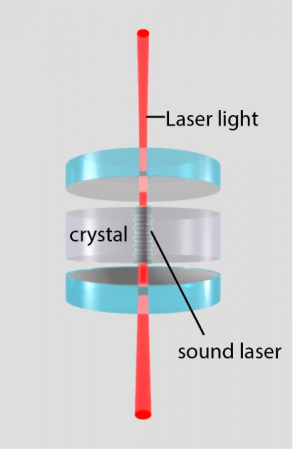
Yale scientists have created a new device that uses laser light to access sound waves and harnessed such light sound interactions to create a new type of “sound laser.”
Acoustic wave devices are perhaps the unsung heroes of modern technologies. Devices that harness the power of sound waves are present in wristwatches and global positioning systems for timekeeping and billions of these devices are used in mobile cellphones as filters to facilitate wireless communication. One of the major advantages of sound waves is that they travel significantly slower than optical waves, enabling storage and manipulation of information in a compact volume and for extended periods of time.
So far, virtually all acoustic wave technologies, like the ones used in our cellphones, rely on electromechanical transduction to generate and detect sound waves. This approach of generating sound waves requires the transducer material to be piezoelectric, a phenomenon through which mechanical motion can be induced by applying an electric field.
Alternatively, laser light can be used to generate forces in a medium allowing us to both transduce and interrogate sound waves. Therefore, optomechanical transduction can open new avenues for harnessing sound waves for new devices and technologies.
A new study describes how laser light can be used to efficiently manipulate sound waves within practically any transparent medium such as quartz, sapphire, and diamond for applications ranging from information storage devices to high power lasers and oscillators. The work is a collaboration at Yale between the labs of Peter Rakich, Associate Professor of Applied Physics and Physics, and Jack Harris, Professor of Physics. Prashanta Kharel, a graduate student in Rakich’s lab, led the effort and is the first author of a study that appeared on April 5th in the online edition of the journal Science Advances.

Figure courtesy Prashanta Kharel.
Kharel said that they have engineered a new device where the interaction between light waves and sound waves can be dramatically enhanced by placing a quartz crystal in between two optical mirrors. The two polished surfaces of the crystalline medium act as mirrors for sound waves, similar to the two optical mirrors that confine the optical waves.
“Within this system, light can be used to efficiently generate sound waves, and when the generation rate exceeds the loss rate, the crystal self-oscillates, meaning we get a very spectrally pure acoustic tone,” Rakich explained. “The observed spectral narrowing of a sound wave in our device is analogous to that observed in conventional optical lasers, so what we have here is a type of sound ‘laser,’” he said.
Just as the invention of spectrally pure laser light has had a tremendous impact on the modern world with applications ranging from gravitational detectors to laser ranging systems, spectrally pure tone of sound waves could open doors to new metrology tools and even precise timekeeping devices.
Beyond classical technologies, these same devices have tremendous potential for storing and processing quantum information. While sound waves typically decay rapidly at room temperatures, they can hang around for astonishingly long times at low temperatures. Moreover, the sound waves harnessed using light can be at high frequencies where they are less sensitive to noise due to the thermal environment. By manipulating such long-lived sound waves using light in a deterministic and efficient way, the group is also working towards harnessing the power of sound waves for emerging quantum technologies.
Co-authors of the new study from the Yale Departments of Applied Physics and Physics include Prashanta Kharel, Glen Harris, Eric Kittlaus, Nils Otterstrom, William Renninger, Jack Harris, and Peter Rakich.
These findings are described in the article entitled High-frequency cavity optomechanics using bulk acoustic phonons, recently published in the journal Science Advances.








